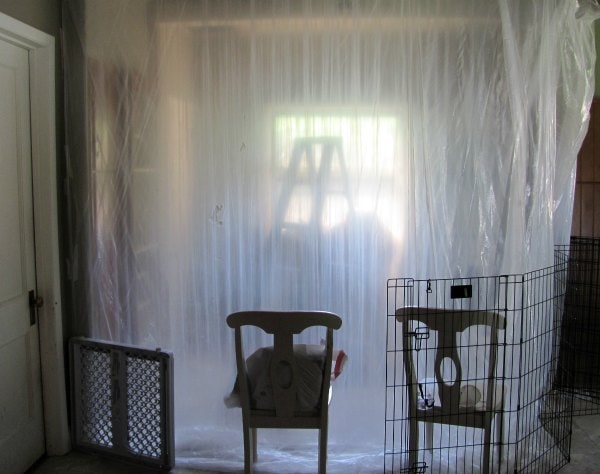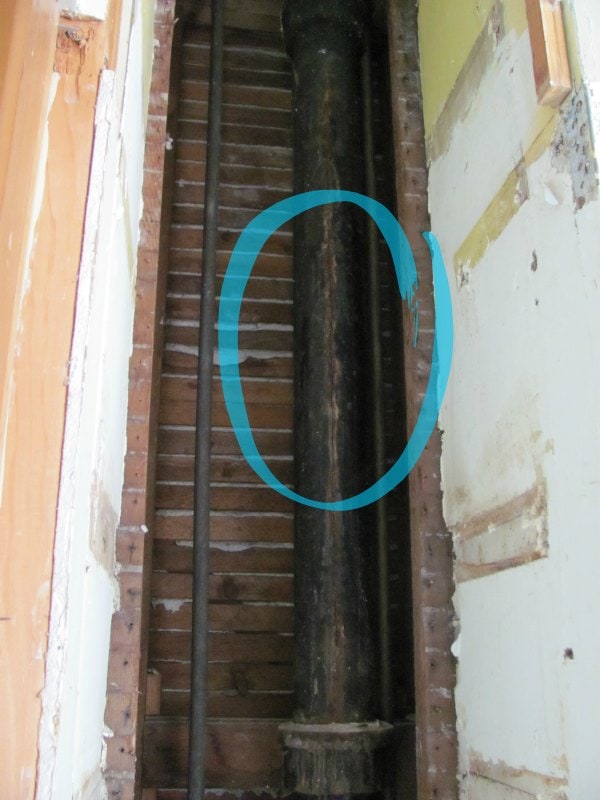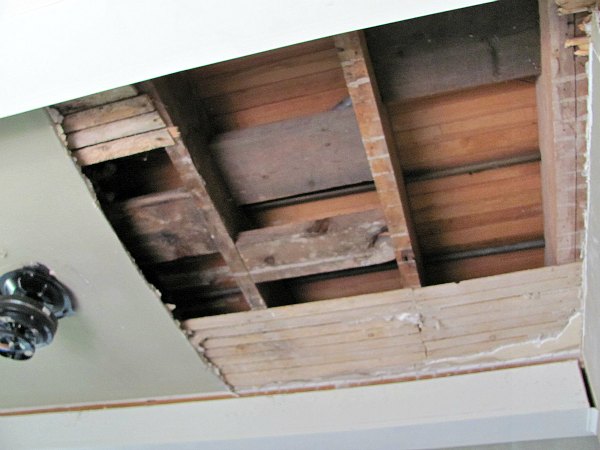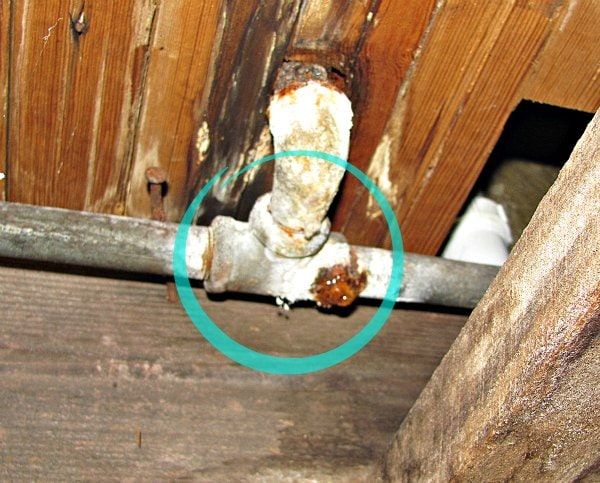There is a lot to love about old houses. Often they were built from top-quality materials that would cost a fortune today. They might come with attractive details such as beautiful wood molding, hardwood floors and leaded glass windows. And compared to newer construction, buying a fixer-upper old house can give you a lot of space for less money.
Unfortunately not all old-house construction technology was built to stand the test of time; newer (at the time) technology like electricity and indoor plumbing utilized materials and methods that are antiquated and potentially problematic. Lurking beneath the surface of a beautiful and solid structure can be ticking time bombs like potentially hazardous knob-and-tube wiring and old pipes that rust and leak.
When we traded our tiny 1960’s cottage for a sprawling (by comparison) 1918 Craftsman home, my husband and I knew something about what we were getting into. However, we have found ourselves rather suddenly in the midst of a major plumbing project sooner than we anticipated.
I thought I’d share our experience so far as a cautionary tale if you’re considering buying an older home. This isn’t to scare anyone away from beautiful old houses, but it’s important to know what you might be signing up for so you can plan accordingly.

Old House Plumbing Problems
Our house was a flip, and while it was pretty to look at, it quickly became clear that much of the work had been about putting lipstick on a pig, not properly rehabilitating an old house. I give the contractor credit for not taking to the beautiful woodwork with spraypaint, but I was frustrated that minimal work was done to the mechanics.
As part of the buying process, I walked through the house with a home inspector to make sure there were no deal-breaking problems, and to take note of the repairs we would need to make.
Opening a large pantry cupboard in the kitchen, I looked up and noticed that the plaster on the ceiling was sagging, and there was a hole where there had clearly been a leak at some point. However, there wasn’t any new moisture that I or the inspector could see, and we agreed that it was probably the aftermath of a long-ago leak.
We ventured into the basement and the inspector noted that the house still had its original cast iron drain pipe. At almost 100 years old, its lifespan was probably limited, and eventually it would need to be replaced.
A removable panel in the bathroom showed that the bathtub plumbing was a wreck. A newer tub had been sloppily connected to old pipes. The drain leaked, and the supply piping was rusted and threatening to burst. We patched those up temporarily after moving in and the leaking in that area stopped (from what we could see).
Replacing all of the bathroom plumbing was definitely on our agenda, but with no apparent urgent issues, we thought we’d be able to spend some time saving up the cash.

A few months after moving in, however, we noticed that water had been dripping in the pantry cupboard in the kitchen where we stored cleaning supplies. It was the same location where I had noted the ruined ceiling. It was winter, and we couldn’t figure out for certain if water was coming from the bathroom above, or if ice buildup was dripping through the roof near the chimney. Sometimes it would drip a lot, other times it seemed to stop.
A few weeks ago when I was reaching for some cleaning products, I noticed that the pantry cupboard was wetter than ever. And, well, not to gross you out, but I realized that it was definitely coming from the bathroom. This problem couldn’t wait any longer. My husband and I set about emptying the pantry cupboard and pulled down the plaster from the ceiling inside. Flushing the toilet sent water raining down, and using the tub or sink would send down a steady drip as well.

Ask an expert
I have a background in architecture, but I worked primarily in new construction and commercial remodeling, so the rehabilitation of historic homes is not my area of expertise. My knee-jerk reaction was “gut the bathroom!!!”
I told my husband we would need to pull up the floorboards in the bathroom, at least one of the walls, and probably the ceiling. We needed to do the project as cost-effectively as possible (we are saving for a trip to England next summer), but that didn’t stop me searching for a new bathroom vanity and bathtub “while we were at it.”
Though I was ready to take a sledgehammer to the bathroom, I wisely contacted a plumber who my neighbor had recommended before we began any demolition work.
The plumber told me that it was impossible for him to give me a number over the phone, and even if he came to the house he wouldn’t be able to give an accurate quote without seeing exactly what was lurking inside the floors and walls, but he would stop over to help determine what steps we should take, free of charge. True to his word, he arrived 15 minutes later. He earned major points just for showing up — I can’t tell you how many times I’ve tried to hire a contractor and they don’t even return my calls.
I brought him up to the bathroom and told him “I know you can’t see much, but don’t worry, we’re going to be ripping up the whole floor soon.”
“Waaaaiiiiit a minute!” he said, looking at our bright, airy bathroom with its newer floor and fixtures. “There’s no reason to ruin this nice bathroom. Ripping up the floor isn’t going to do much for me — I need access from below.”
We went down to the kitchen and he showed me where we could remove portions of the ceiling to access the pipes, and it would be much easier to repair drywall than replace an entire floor.
He couldn’t give me an estimate without seeing exactly which circumstances he would be dealing with, but eventually he gave me a ballpark figure of around $1500 to replace all of the plumbing, including the cast iron drain pipe and the water supply piping.
He acted as though his $1500 figure would cause me to drop dead on the spot, but I was doing cartwheels in my mind because I had feared he’d say something more like $6,000. Yes, $1500 is a lot of money, but considering what we will gain, I was very happy with the price.
I was especially grateful for the plumber’s years of experience, his willingness to do an annoying job that others would turn down, and for the time he took to help me determine a plan of action. He left me feeling much more confident about the whole thing, and I was reminded that it’s always good to get a second opinion — my well-meaning plans were completely off base.
DIY Demolition
Completing most of the demolition ourselves will save quite a bit of money, as it cuts down on labor time.
The weekend after the plumber visited, my husband and I set about ripping into our kitchen ceiling and the pantry cupboard wall to expose the old piping. First, we hung plastic sheets around a corner of our kitchen to protect the rest of the house from flying dust, mold and whatever other unpleasantness we might discover. We also used protective masks and goggles to protect ourselves from flying dust and debris.
Our first step was to expose the cast iron drain pipe. We gave the plaster wall a few whacks with a hammer, then used a crowbar to pry off plaster and lath. I was immediately grateful that we decided to tackle this problem now. The section of pipe we could see from the basement seemed solid, but the section behind the pantry cupboard was rusted, and a long crack was forming. It doesn’t look to be cracked all the way through yet, but the drain pipe could have failed at any time.

We found that the leak issue is happening where a lead tee joins into the cast iron pipe. Water trickles down between two floor joists. Despite this, the high quality wood seems to be in good condition, and now that the area is exposed, it can dry.

Next, we worked on cutting away the ceiling to uncover the bathtub pipes. We used an oscillating tool to saw along straight lines, which will make it easier to patch the holes later. The kitchen ceiling consisted of drywall over plaster over lath. We found two old mouse nests and zero hidden treasures.

The tub had leaked so much in the past that the old plaster ceiling was completely separated from the lath. Nails fastening the lath to the floor joists above had rusted through. In short, there was little holding the ceiling in place, and the heavy ceiling fan that had been screwed into that mess could have plunged to the floor at any time. Yikes!
The gypsum board and some lath had mold growth, but fortunately the permanent structure did not. I’m glad to have that unhealthy stuff out of our house.
After removing the ceiling we discovered an additional leak along the tub’s supply piping that we never would have been able to see. It had been steadily dripping water all along. Back when our house was built, supply piping was a mix of cast iron, galvanized steel or brass (we’re fortunate our house doesn’t have lead except for drain piping), and some of those materials eventually oxidize. The threaded joints are prime locations for leakage to occur.

Home improvement is significantly less fun when you’re already pinched for time and tired out by young kids. I am not thrilled that my kitchen is a shambles, and it’s an inconvenience having our main bathroom out of commission. But, on the bright side, our emergency fund is healthy enough to handle this mess, and the demo work has been much easier than I anticipated.
It feels good to know that by the end of this project, our house will have brand new plumbing that we won’t need to worry about again. This is, I think, the most major house project we will need to undertake. It will feel like a weight off my shoulders when the work is done.
We have a little bit more demolition to complete, and then I’ll have the plumber back over to take another look and give me a more concrete estimate. He told me it should take about a day and a half to complete, which isn’t bad. Once the project is done I’ll post again with a recap and more details.
Look before you leap
Based on my experiences so far, I can give the following old house advice:
- Before you buy, find out if the plumbing has been updated and to what extent. Plan to replace old plumbing made from materials that won’t hold up, even if it doesn’t seem to be a problem. It eventually will be.
- Talk to neighbors about which contractors they would recommend. My neighbor recommended a plumber who has replaced plumbing in old houses being converted into apartments — I knew that was the kind of experience I needed.
- Get a second opinion before you start any work. Gutting my bathroom wouldn’t have given the plumber the access he needed, and I would have wrecked things that could have remained intact. His walkthrough was free and his insight was invaluable.
- Don’t spend money on decorative finishes until the mechanics are taken care of. I have grand plans for my kitchen, but I’m glad I didn’t paint yet — my work would have been ruined, and money wasted.
Have any of you dealt with old house plumbing problems? I’d love to hear about your experiences.

At my advanced years, my thoughts on reading your tale were mainly how good it is that you and your husband are young, and smart, and determined. I would have had to have a cup of tea and go to bed with the vapors.
Oh, I have definitely had my moments when I have wanted to do just that! Getting some feedback from an expert helped me feel a lot better about this whole ordeal.
Great walk through, Jen. You guys seem so competent to handle this on your own (minus the plumbing). Well done! Can’t wait to hear part 2! $1500 is not bad, did you end up getting a second plumber quote or are you going with this guy?
Thanks! On this particular project I think I am just going to hire the guy who came over, for a variety of reasons. I’ve contacted other plumbers in the past, and they wouldn’t even get back to me after I described the situation. Finding a good, competent contractor in this area is a nightmare!
Our home is a bit younger than yous (built in 1929) and plumbing has been the consistent problem. From an 18-month-old water heater failing and flooding the basement to our old drum trap in the bathroom upstairs failing and raining in the kitchen. You found a great plumber if he’ll do that job for only $1,500!
Sorry to hear you’re dealing with this stuff, too! Hopefully the price he gave me is fairly accurate. The biggest cost is labor, so if it ends up being more difficult than he anticipated, it could cost more. We shall see.
“I was immediately grateful that we decided to tackle this problem now.”
Next time, I strongly encourage you try the plumbing too. It is surprisingly easy. Before we bought our current old house, my plumbing experience was limited to replacing toilets and minor repairs. After reading some books at the library and watching YouTube videos, I redid all of the original supply lines in the home and also completely plumbed our new addition (2 bathrooms, waste and supply). It’s very easy to connect up PVC or ABS with the old cast iron. I could walk you through it on a call, seriously.
We did get quotes for all of the work too. After I discovered how easy it was though, there was no way I’d pay anyone for it.
The whole problem with plumbing is that the work has changed, but the cost hasn’t. It used to be a hard skill where you’d have to melt lead and work with solder and copper. Now, with PVC, ABS and PEX, its a bit like a big LEGO set. I dare say that its even fun.
Wish I was closer so I could give you some hands on help.
I’ll definitely look into it more this weekend and see if there’s more we can do before pulling the trigger. Our cast iron is in very poor condition, so I’m thinking just tying into it isn’t a good idea, but I’ve read before that sometimes wrapping the existing with PVC is a possibility. That drain pipe is the one thing that really has me concerned. My dad has done supply piping (he did new plumbing for our washer), so that may be an option to save some money.
I’ve been a plumber for 25 years and have seen many homeowners “fix” plumbing problems. Most of the time the problems get worse. Sections of cast iron can be unsecured or broken above the work area, and they weigh hundreds of pounds. It can be a dangerous situation, and it’s not fun. Mr 1500 can probably fix your car, your roof and rewire your house too. For larger projects like this, leave it to a professional. I’d make sure there is a plumbing inspection also.
I would be way too scared to work on ANY kind of plumbing issues myself. I’m an extremely paranoid person and as soon as I think anything is wrong I like to “google” the topic and usually get some ease after that.
Hehe…I rely heavily on Google, too. Usually I end up scaring myself even more. I’ve learned to do some plumbing basics over the years, but this is definitely outside my comfort zone.
Plumbing is no fun at all. I have had so much trouble with the plumbing behind my shower that at some point I am going to need to pull it all out and give it a redo. But until then, its all patch work to keep it working (and dry) for now. Thanks for sharing!
Definitely not fun! Even when it’s patched up temporarily, I can’t stand the nagging feeling that it’s just not right. Thanks for reading!
Plumping problems are the worse. I always get terrified whenever I hear something odd coming from my bathroom or kitchen area.
Thanks Jennifer! I see the pictures the first time. now I am clear what old house plumbing problem could be.
This may help me determine buying the house of 1949 that we are interested or not..
Thanks and very interesting. When we moved into out 1930’s house almost all of the plumbing was lead, the greatest difficulty was getting it out (it was part of the fabric of the house) modern plastic plumbing is easier then Lego to put together and nearly always works first time even copper fitting are much easier to work with then lead. Good luck with the rest( and if you do visit England there is more to see than just London)
Thank you! My husband is from South Yorkshire, and I studied in Sheffield. I have seen quite a bit of England (and want to see quite a bit more). London is wonderful, but I love the countryside.
Excellent, no less than the best bit (we are in North Yorkshire)
You didn’t say what you did to the soil pipe after it entered into the basement. I had the soil pipe replaced, even though no crack. He found junk inside, but the hole was in the vent pipe. The soil pipe does a double curve beneath the first floor to the basement new cleanout to the sewer. Plumber says it means cutting through a support beam to replace that section. That section might have a heavier iron. As I said, you didn’t mention that part!
I’m sorry for the late response, Sharon. For some reason I didn’t get a notification that there was a new comment! We were able to save the portion of our soil pipe that is in the basement, as it was in fine condition. Our plumber removed the cracked pipe and connected new PVC to the iron pipe in the basement. You have probably already acted on this, but if not, it is always good to get a second opinion.
my bathroom drain plumbing below the floor has metal bucket type of waste catcher, plumbed in . I want to remove it, my drain is clogged.